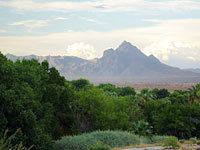 | ||
Similar Moapa Valley National, Las Vegas Wash, Desert National Wildlife R, Springs Preserve, Virgin River | ||
Warm springs natural area
The Warm Springs Natural Area, also known as the Warm Springs Ranch, is located near the Moapa Indian Reservation in Clark County, Nevada, at an elevation of 2,123 feet (647 m). The 1,179-acre (477 ha) area is owned by the Southern Nevada Water Authority (SNWA). The area is a natural oasis in the Mojave Desert. The oasis is fed by close to 24 natural warm springs and contains many naturally occurring California fan palms (Washingtonia filifera), creating an ecosystem normally limited to the "low" Colorado Desert and so unique to the "high" Mojave Desert. The springs are the headwaters for the Muddy River.
Contents
- Warm springs natural area
- Warm springs natural area a jewel in the desert
- History
- Moapa Valley National Wildlife Refuge
- References
The area is popular for residential and recreational uses. There are year round residents that own private property with homes. There are camping areas for recreational vehicles and a private, multi-use, recreation area owned by The Church of Jesus Christ of Latter-day Saints (LDS Church).
Warm springs natural area a jewel in the desert
History
Howard Hughes purchased the 1,218-acre (493 ha) ranch in 1968. The LDS church acquired the Ranch in 1978 and attempted to continue its use as an operating ranch. When they were unsuccessful in ranching including cattle grazing, the LDS church sold most of the land, keeping 75 acres (30 ha) operated as the Warm Springs Recreational Ranch.
The Southern Nevada Water Authority acquired the area in 2007.
Moapa Valley National Wildlife Refuge
The United States Fish and Wildlife Service established the Moapa Valley National Wildlife Refuge area of Warm Springs as a wildlife preserve to protect the habitat of Moapa dace, a critically endangered species of fish that is endemic to the Muddy River. The Moapa dace have declined in population due to habitat destruction and introduced species of non-native fish. This unique small area of 106 acres (43 ha), and the fish, have many stakeholders in their ongoing preservation.
